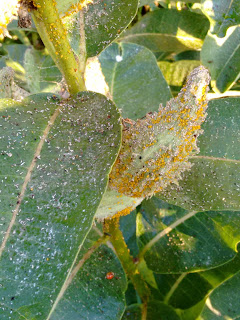I’ve heard of it happening to others. But it has never
happened to me…until this year. My milkweed plants are covered with hundreds of
tiny orange-yellow aphids, creatures that I’d probably find cute under
different circumstances. However, their infestation has made my milkweed
inhospitable for wayfaring Monarch butterflies.
Applying pesticides isn’t an option, especially not in a
pollinator garden.
Pesticides are indiscriminate, killing desirable insects
along with the unwanted. Since I grow milkweed primarily as food plants for
Monarch butterfly caterpillars, it doesn’t make sense to use chemicals that
will kill Monarchs (and other pollinators). How can I deal with this aphid
infestation in a way that doesn’t harm my garden’s whole community?
The plague afflicting my milkweed is oleander
aphids, sunny yellow, tear-shaped little blobs. A species originally
from the Mediterranean region, oleander aphids, Aphis nerii, are now found worldwide. If they weren’t so
problematic, I’d find them fascinating. All wild oleander aphids are female;
males don’t occur in the wild. Oleander aphids reproduce by parthenogenesis,
asexual reproduction. So, answering the
question of the geneticist in Jurassic Park—“You're implying that a group
composed entirely of female animals will... breed?”—absolutely yes! And they’re
doing it in my garden!
But I quickly move past the movie-worthy life history of
oleander aphids when I look at what they’re doing to the milkweed. Like other
aphid species, they have piercing mouthparts through which they suck up sap.
Aphids inflict aesthetic damage on milkweeds—leaves become covered with sticky aphid
honeydew, which traps dirt and waste. Even the undersides of milkweed leaves,
where Monarch butterflies lay their eggs, become debris-smeared.
However, the damage goes beyond aesthetic. Many of the milkweeds
in my garden are stunted, yellowed, and weakened. Leaves coated with honeydew and debris also deter Monarchs
from laying their eggs. I’ve seen female Monarchs fly through the garden,
alighting briefly on leaves, but never stopping to lay an egg. Although I’ve
found a few caterpillars, I suspect that their survival on infested plants may
be lower than on healthy plants.
Aphid damage has also lessened the supply of healthy
milkweed leaves I need to head-start Monarch caterpillars indoors. I bring
Monarch eggs inside and allow them to hatch and complete metamorphosis in the
safety of terrariums. I supply these caterpillars with milkweed leaves—the only
food that Monarch caterpillars can eat.
Putting leaves into water-filled floral tubes, in past years, has kept them fresh for a couple of days. But
this year, more than half of the leaves I bring indoors wilt within an hour or
two. I’ve had a hard time keeping my little group of ravenous, growing caterpillars
fed.
So, what shall I do about the aphids without hurting other
garden insects? Much of my yard’s milkweed this year is already ruined. For
now, I’ve started removing the most
heavily infested milkweed plants from the garden. My main concern is how to
avoid an aphid explosion next year. After reading the advice and experiences of
others, I realize that I could have taken steps to prevent this year’s
infestation from getting out of control. I’ve gotten helpful ideas from a site
about maintaining a Monarch butterfly garden; it includes an article about How to Control Aphids on Milkweed Plants. I’ll
be trying some of these techniques next year.
My eco-friendly aphid battle plan will include:
●
Checking plants regularly to detect aphids as
soon as possible.
●
Mechanical control: Squishing aphids and
removing them by hand whenever I see them.
●
Spot treatment with isopropyl alcohol as needed:
Dabbing aphids with a cotton ball soaked in isopropyl alcohol will kill them.
Care must be taken to avoid Monarch eggs and caterpillars.
●
Avoiding pesticides, of course.
At the end of this post, I’ve included links to some sites
I’ve found describing options and issues related to controlling aphids on
milkweed.
It will take a lot of hands-on work and
attention. I’ll need to be diligent to keep oleander aphids from overrunning my
milkweed next year. But, the reward will
be a healthy garden that’s welcoming to Monarch butterflies—well worth the hard
work!
Some Selected References




No comments:
Post a Comment